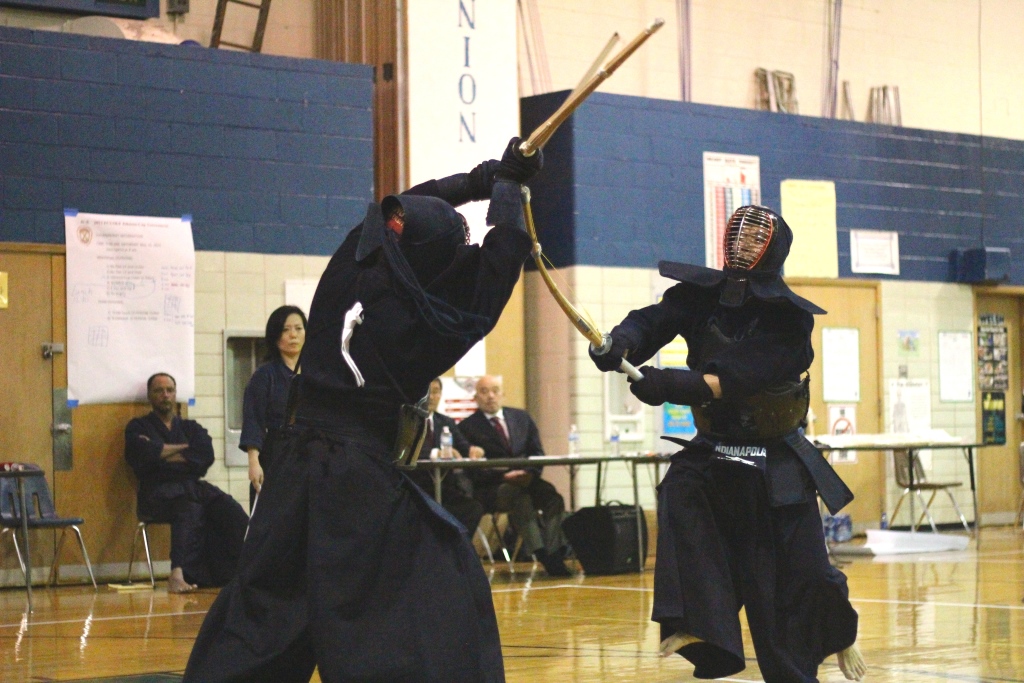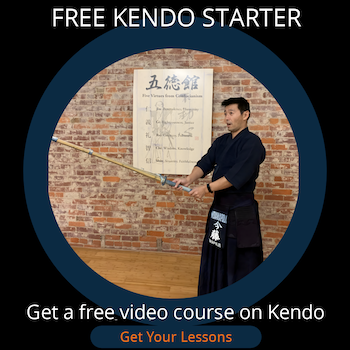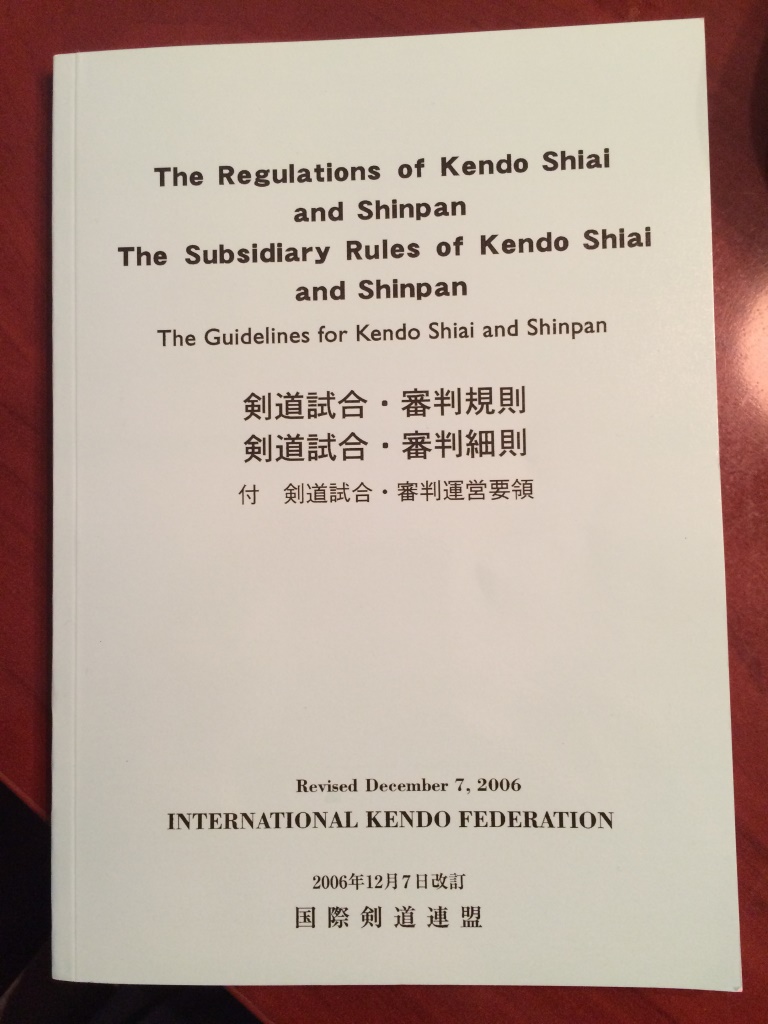You Got It!
Match in Kendo or Shiai

Match in kendō or shiai is to fight to gain a point by striking a target. This is how to fight in kendō.
In kendō match, we call shiai,
the targets we aim at are men
(forehead), kote (the protection part
from the wrist toward the elbow) or dō
(trunk) or thrust a throat or tsuki.
When you strike those targets or thrust tsuki satisfying certain criteria of a valid cut, then you will be given a point by referees.
Criteria of a Valid Cut
In kendō shiai, just hitting a target is not a good enough. There are certain criteria that you must satisfy to have your technique considered to be valid.
- You must strike/thrust the right target (datotsu-bui) with the right part of the bamboo sword or shinai (datotsu-bu).
- The angle of the shinai (hasuji)must be correct
- The level of your internal energy (ki) must be high and you must be filled with it.
- You must show Ki Ken Tai Icchi (Integration of your internal energy, sword and body)
- You must have the appropriate posture when striking
- You must show zanshin.
You might wonder what the appropriate posture is. How to show zanshin? Now you should know these things because you are always supposed to practice those in your keiko.
There are no difference between shiai and keiko in how you should have the appropriate posture and how to take zanshin.
In kendō, it is important to strike/thrust a target properly but also the PROCESS and how you conclude your strike is also important to get a point.
How Many Points Should You Get To Win?
Usually we apply 3 point match. That means whoever gets 2 points first wins.
If only one point gains by one person before the time is up, then that person wins. If both did not get points or got 1 point each before the time is up, then it is a draw.
Of course, in an individual tournament, we need to decide a winner. So enchō is applied. Enchō means an extension. Duration of enchō is usually 3 minutes. But it differs depending on the tournament rules of the day.
Now there are individual fight and team fight in kendō. Even in the team fight, only two competitors fight at a time; one competitor from each team. Only one on one.
What’s Team Fight?
Even though it is a team fight, you fight alone in kendo. But you have to fight so your team can win. This is the main thing you have to remember when you participate in a team fight.
This means you have to know how you should fight to
- Win
- Draw
- Lose by one point (never lose by 2 points!)
In the team, you will be assigned a position. Usually there are 5 positions. Depending on tournament styles, there are 7 positions or even more. But 5 is commonly applied.
These are the 5 positions in kendō.
- Sempō (1st fighter)
- Jihō (2nd fighter)
- Chūken (3rd fighter)
- Fukushō (4th fighter)
- Taishō (last fighter)
What Type of Player Should Be Assigned for Each Position and What They Are Expected to Do
1. Sempō: energetic, create momentum for the team
2. Jihō: energetic, re-create momentum for the team when sempō loses, keep momentum that sempō created
3. Chūken: trustworthy, responsible, win if the first 2 loses
4. Fukushō: calm, trustworthy, correct judgement
5. Taishō: ideal kendō of the team, show pride, reliable
(These are probably rather subjective and I am sure there are different opinions on this).
Sempō: Sempō is the first player to fight for the team so he/she can fight to create momentum for the team. Even if he/she loses, if they create good momentum, the energy level of the team raises. This is the most important role for the sempō.
Jihō: Jihō must keep the good momentum that sempō creates. If sempō failed to create momentum and the energy level of the team goes down, so the jihō must re-creates momentum.
Chūken: If the first two loses, chūken must NOT lose because if chūken loses after the first two players lost, then the team loses. So chūken cannot lose here. The best result chūken fights for is to win by two points. Then win by one point. And draw.
Fukushō: Fukushō must calmly observe what is going on in the shiai. He/she must counts points the own team gained and the other team gained. Fukushō must create a good situation for taishō so taishō can conclude the team fight in a way for the team to grow for the future.
Taishō: Taishō, of course, should win when the team is losing. But most importantly, taishō of the team must show the pride and kendō of the team. Even when the team has already lost before the taishō fights, taishō must fight with the pride and dignity so he/she can conclude the shiai in a good way.
Daihyōsen (the representative fight)
Daihyōsen is a representative fight when the numbers of winners and points gained between the two teams are the same. Take a look at the table below.
|
Sempō |
Jihō |
Chūken |
Fukushō |
Taishō |
Winners/ |
Daihyōsen | |
|
Team A |
M |
M |
|
|
|
2/3 |
|
|
Team B |
K, D |
|
T |
M |
|
2/3 |
|
The number of winners of team A is two. And the number of points that team A earned is 3. Team B has two winners and 3 points. They have the same numbers in winners and points. So they choose one person to fight to decide which team wins, which is called daihyōsen.
Daihyōsen is usually one point match (the first one who gets a point wins) and no time limitation. Of course, it depends on the tournament rules so you always have to know about the tournament rules of that day.
International Kendo Federation Rule Book
We have an "International Kendo Federation Shiai and Shinpan Regulations" book issued by International Kendo Federation (FIK).
This is the basics of kendo match or shiai. So make sure you get one and read through the rules.
Shinpan (referee) is very hard to do for inexperienced kendo practitioners.
So firstly, you should participate in shiai as often as you can. Of course, you should learn basic terms and what to do at shiai.
Secondly, start learning why certain points are valid and others are not.
After participating shiai, you will learn a lot by thinking about what are valid and what are not.
Like kendo, shinpan as well, you should do it to become better at it. So when you have a chance please try and polish up your shinpan skills!


